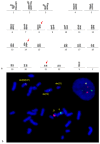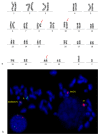Fusion Gene-Based Classification of Variant Cytogenetic Rearrangements in Acute Myeloid Leukemia
- PMID: 36833323
- PMCID: PMC9957481
- DOI: 10.3390/genes14020396
Fusion Gene-Based Classification of Variant Cytogenetic Rearrangements in Acute Myeloid Leukemia
Abstract
Acute myeloid leukemia (AML) represents a heterogeneous disease entity that is continuously moving to a more genetically defined classification. The classification of AML with recurrent chromosomal translocations, including those involving core binding factor subunits, plays a critical role in diagnosis, prognosis, treatment stratification, and residual disease evaluation. Accurate classification of variant cytogenetic rearrangements in AML contributes to effective clinical management. We report here the identification of four variant t(8;V;21) translocations in newly diagnosed AML patients. Two patients showed a t(8;14) and a t(8;10) variation, respectively, with a morphologically normal-appearing chromosome 21 in each initial karyotype. Subsequent fluorescence in situ hybridization (FISH) on metaphase cells revealed cryptic three-way translocations t(8;14;21) and t(8;10;21). Each resulted in RUNX1::RUNX1T1 fusion. The other two patients showed karyotypically visible three-way translocations t(8;16;21) and t(8;20;21), respectively. Each resulted in RUNX1::RUNX1T1 fusion. Our findings demonstrate the importance of recognizing variant forms of t(8;21) translocations and emphasize the value of applying RUNX1::RUNX1T1 FISH for the detection of cryptic and complex rearrangements when abnormalities involving chromosome band 8q22 are observed in patients with AML.
Keywords: RUNX1::RUNX1T1 fusion; acute myeloid leukemia; complex rearrangement; cryptic translocation.
Conflict of interest statement
The authors declare no conflict of interest.
Figures




References
-
- Vardiman J.W., Thiele J., Arber D.A., Brunning R.D., Borowitz M.J., Porwit A., Harris N.L., Le Beau M.M., Hellström-Lindberg E., Tefferi A., et al. The 2008 revision of the World Health Organization (WHO) classification of myeloid neoplasms and acute leukemia: Rationale and important changes. Blood. 2009;114:937–951. doi: 10.1182/blood-2009-03-209262. - DOI - PubMed
-
- Khoury J.D., Solary E., Abla O., Akkari Y., Alaggio R., Apperley J.F., Bejar R., Berti E., Busque L., Chan J.K.C., et al. The 5th edition of the World Health Organization Classification of Haematolymphoid Tumours: Myeloid and Histiocytic/Dendritic Neoplasms. Leukemia. 2022;36:1703–1719. doi: 10.1038/s41375-022-01613-1. - DOI - PMC - PubMed
-
- Arber D.A., Orazi A., Hasserjian R.P., Borowitz M.J., Calvo K.R., Kvasnicka H.M., Wang S.A., Bagg A., Barbui T., Branford S., et al. International Consensus Classification of Myeloid Neoplasms and Acute Leukemias: Integrating morphologic, clinical, and genomic data. Blood. 2022;140:1200–1228. doi: 10.1182/blood.2022015850. - DOI - PMC - PubMed
-
- Appelbaum F.R., Kopecky K.J., Tallman M., Sovak M.L., Gundacker H.M., Kim H.T., Dewald G.W., Kantarjian H.M., Pierce S.R., Estey E.H. The clinical spectrum of adult acute myeloid leukaemia associated with core binding factor translocations. Br. J. Haematol. 2006;135:165–173. doi: 10.1111/j.1365-2141.2006.06276.x. - DOI - PubMed
Publication types
MeSH terms
Substances
Grants and funding
LinkOut - more resources
Full Text Sources
Medical

